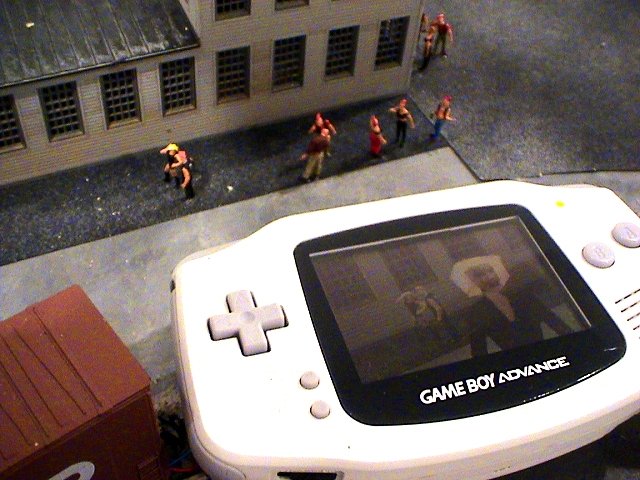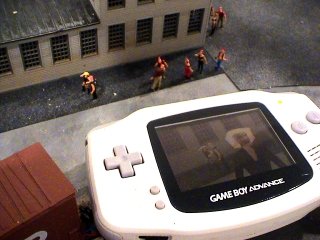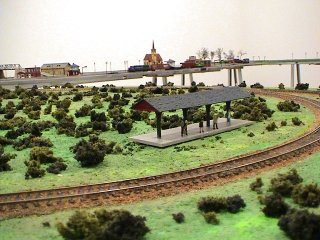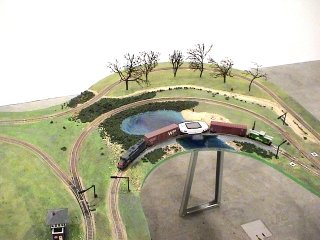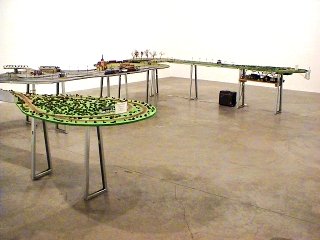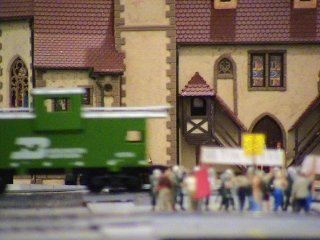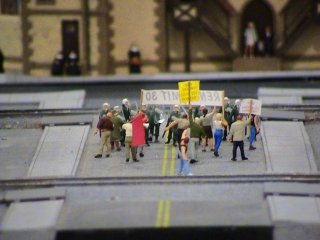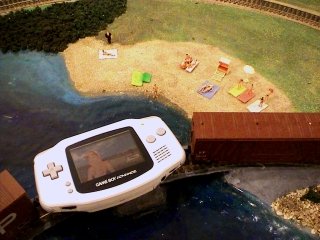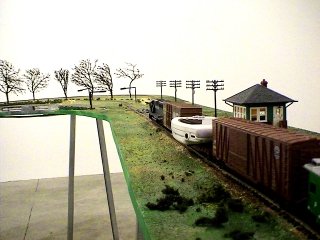| Train
is a unique and original take on "mobile computing" and "the moving
image."
A cinematic narrative in miniature, Train spans the history of
technology
and it's impact on culture and the aesthetics of representation.
The scene: A
15 x
23 foot model railroad layout that the artist painstakingly constructed
by hand. The landscape seems familiar and, at the same time, awkward: a
beach with azure blue waters juxtaposed with a bleak cityscape cum
factory
and protesters; an idyllic church next to an overpass and ambulance
signaling
disaster. Visitors to the gallery can navigate the landscape by using a
phone (or their own cell phones) to control each of the two trains as
they
make their way around the track. The trains haul a special cargo, a
Nintendo
Gameboy hand-held game device, which presents the view out of the
train's
window -- a rendered 3D image reflecting the model scenery as the train
travels through it. When a train stops, viewers are able to make
choices
by pressing buttons on their cell phone; they may choose the route and
'pick up' passengers along the way.
|
The
characters: The 8 passengers who can be selected are not everyday
people
but famous movie stars, for example, Juliette, a free spirited young
French
woman (Brigitte Bardot from Roger Vadim's "And God Created Woman");
Vincent,
a troubled painter (Kirk Douglas as Vincent Van Gogh in "Lust For
Life").
Also on board are Sally Field as "Norma Rae," Chloe Webb as Nancy from
"Sid and Nancy," Nicholas Cage (in a double role) as the drunk in
"Leaving
Las Vegas" and the ambulance driver in Scorcese's "Bringing Out the
Dead,"
Harvey Keitel as the "Bad Lieutenant," and Rebecca DeMornay as the
prostitute
in "Risky Business." The landscape of the train alludes to scenes from
the movies, with little figures representing the characters themselves.
When viewers have selected two or more passengers, the characters
appear
on the Gameboy and begin to have a conversation that can be overheard
on
the cell phone. The conversations are built out of sound clips from the
respective roles and assembled 'on the fly.' Klima composed a complex
'conversation
engine,' taking into account the personalities of the characters and
creating
a myriad of situations where the sex symbol and the drunk, the artist,
prostitute, and punk can argue, console, flirt, and sometimes even
downright
insult each other, all depending upon who is on board the train. The
foray
into storytelling constitutes a whole new territory for Klima, who, up
to this point, "avoided narrative like the plague," to quote the artist. |
